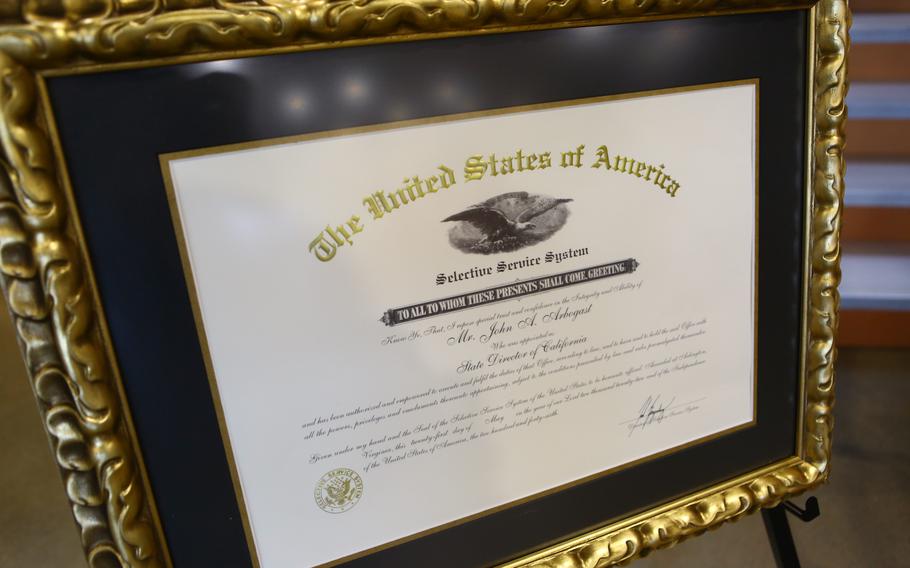
A framed appointment certificate is displayed for John A. Arbogast, the Selective Service System’s new state director for California, before his swearing in ceremony, March 13, 2023, at Joint Forces Training Base, Los Alamitos, Calif. (Crystal Housman/U.S. Air National Guard.)
When Russia annexed Crimea in 2014, many heralded a new era of warfare. Short wars waged by small professional forces seemed to be the way of the future. Authoritarian actors, it was argued, could use the Crimean fait accompli as a blueprint to undermine Western military dominance by disguising aggression and denying the United States time to respond. Nine years later, Russia’s war with Ukraine has exposed the flaws in this prediction. A Crimea-style “special military operation” designed to swallow up all of Ukraine in one swift action has devolved into a slog with no end in sight and hundreds of thousands of lives lost.
As the two countries scramble to fill their depleted ranks, it has become painfully clear how unprepared both sides were for a lengthy conflict. In Ukraine, stories abound of recruiters raiding gyms and shopping centers to drum up recruits. Many men who were officially disqualified from service are now being drafted while healthy men flee the country or bribe officials to escape service. Some videos have even surfaced online allegedly showing Ukrainian recruiters physically stuffing men into vans bound for recruitment offices. Such desperation is a far cry from the beginning of the war when Ukrainian men flooded into recruitment stations to serve their country.
Even Russia, a country with three times the population of Ukraine, has had to take drastic measures to meet its manpower needs. Despite a massive advertising campaign and enticing financial incentives, Moscow is struggling to find volunteers. The draft, meanwhile, is deeply unpopular, especially as Russia’s outdated conscription system has struggled to efficiently prepare men for service. With the Russian presidential election mere months away and the Wagner mutiny still fresh in his mind, President Vladimir Putin will want to avoid another mobilization that could lead to further domestic unrest. Instead, Moscow has recruited prisoners, forced men in its occupied Ukrainian territories to fight, and offered expedited citizenship to foreigners who volunteer for service.
Such harsh recruitment tactics seem draconian in the United States where the All-Volunteer Force (AVF) has supposedly relegated conscription to the trash heap of history. The Russo-Ukrainian War, however, shows that this assumption is dangerously flawed. In its 50-year history, the AVF has never suffered casualties that even approach those of this conflict. Ukraine has suffered around 180,000 casualties while Russia has lost roughly 90% of its prewar army all in less than two years of war. Compare that with the U.S. military’s experience in Iraq and Afghanistan where it suffered 7,000 combat deaths in 20 years. While any loss of life is a tragedy, this comparatively small number stretched the U.S. military to its limit despite the consistent deployment of reservists and contractors.
If the U.S. Army, the largest American military branch, were to suffer Ukraine-level casualties, it would lose around 40% of its force size well over the 30% casualty threshold at which U.S. military doctrine deems a force destroyed. The Army would not be able to sustain itself with volunteers alone, especially in a country where young people’s propensity to serve has plummeted to just 9% with no increase predicted in the near term.
Those who say that there is no way back from the AVF ignore the reality that it was never a complete solution. The Gates Commission itself, the body that first recommended establishing the AVF, recognized that conscription would be necessary in “an emergency requiring a major increase in forces over an extended period.” A protracted war of attrition like the Russo-Ukrainian War would certainly fit this description. While the United States maintains the Selective Service System (SSS) for such a contingency, the system has neither been tested nor modernized since the AVF’s creation after the Vietnam War.
It is not realistic to assume that the U.S. military will simply never get involved in another large-scale conflict again. Whatever happens in Ukraine, Putin’s Russia will continue to cast a long shadow over NATO allies in Eastern Europe. Meanwhile, China’s threat to Taiwan will continue to grow. If the United States were to come to the island’s defense, war games predict massive casualties that would shatter the current AVF especially if the conflict protracts as recent research predicts it could.
Washington needs to stop thinking of conscription as a relic of the past and the SSS as a vestigial government body. Instead of routinely debating whether to eliminate the SSS, Congress should modernize it, test its weaknesses and ensure that it is truly ready to be called upon at a moment’s notice. If the United States fails to adequately prepare in this way, it could end up like Ukraine or Russia, scrambling to fill its ranks with an archaic and overwhelmed conscription system that most Americans never thought they’d have to use.
Andrew Spafford is a researcher with Center for a New American Security’s Military, Veterans, and Society Program.